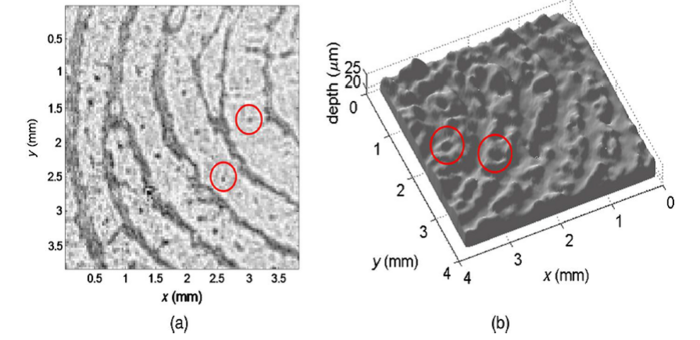Over the past ten years, the Holography and Metamaterials (HaM) Lab at the University of Dayton’s Department of Electro-Optics and Photonics has produced ground-breaking work in dynamic and digital holography.
 (a) Reconstructed amplitude at wavelength 514.5 nm of a CTF-developed fingerprint on a transparent glass slide and (b) topogram of the CTF-developed fingerprint. The red circles identify level-3 details (pores). The hologram was recorded at a recording distance d = 40 cm using dual wavelengths 514.5 nm and 457.9 nm in the transmission mode. Image Credit: Haowen Zhou, Mallik M. R. Hussain, and Partha P. Banerjee.
(a) Reconstructed amplitude at wavelength 514.5 nm of a CTF-developed fingerprint on a transparent glass slide and (b) topogram of the CTF-developed fingerprint. The red circles identify level-3 details (pores). The hologram was recorded at a recording distance d = 40 cm using dual wavelengths 514.5 nm and 457.9 nm in the transmission mode. Image Credit: Haowen Zhou, Mallik M. R. Hussain, and Partha P. Banerjee.
Under the direction of Professor Partha Banerjee, the lab has investigated a wide range of subjects, including photorefractives, self-organization of light, digital holography, holographic tomography, integration of holography with 3D virtual reality, dual-wavelength techniques for characterization of raindrops and cracks, recording and reconstruction of 3D fingerprints.
Other subjects include 3D characterization of additively manufactured objects, transport of intensity and phase, combining transport of intensity with holographic reconstruction, the connection of holograms for 3D object identification, and much more.
In addition, Analog and Digital Holography with MATLAB, a book written by three of the department’s Ph.D. students who studied the subject, was published on the subject.
Numerous projects have received funding from the US Department of Defense, and these projects have facilitated collaborations with Tsinghua University, attracted Fulbright scholars from Bulgaria, as well as students from Shanghai University and Huazhong University of Science and Technology, to work in the research facility.
A 2017 article in Laser Focus World, titled “Virtual Reality Technology: Digital holographic tomography creates true 3D virtual reality,” states:
“Partha Banerjee’s research group at the Holography and Metamaterials Lab at the University of Dayton (Dayton, OH) is using a Mach-Zehnder interferometer setup to scan different faces of an object and record a series of holograms that all contain both intensity and phase (or depth) information of the illuminated surface.”
“These are then reconstructed and tomographically combined to create a true 3D rendering of the object that is stored in a point cloud. Using commercial Microsoft HoloLens software, the object can then be viewed in full 3D detail for a variety of virtual reality (VR) applications”.
The development and reconstruction of high-resolution topograms of fingerprints using dual wavelength digital holography are described in the work on 3D fingerprinting that is detailed in this LAM paper and announced earlier in Optical Engineering. Since each fingerprint is distinct and easy to record, fingerprint analysis is a common identifying method.
Various factors, including the time of day, the temperature, and the makeup of sweat, can affect the quality of a latent fingerprint on a surface.
Researchers used transmission-/reflection-mode dual wavelength digital holography to create the topograms of CTF-developed fingerprints on transparent/blackened glass slides in collaborative efforts with the Pennsylvania State University, where latent fingerprints on transparent and blackened glass slides were established by inserting 1000-nm-thick columnar thin films (CTFs) of chalcogenide glass.
To resolve pores with a depth of 1 to 2 μm, a synthetic wavelength of 4 μm was adequate. The level-3 features of latent fingerprints that are typically difficult to notice with most other approaches can be measured with this approach. The Criminal Investigations and Network Analysis (CINA) Center of the Department of Homeland Security recently provided funding for ongoing efforts in this area to commercialize 3D fingerprinting.
Journal Reference:
Zhou, H., et al. (2022) A review of the dual-wavelength technique for phase imaging and 3D topography. Light: Advanced Manufacturing. doi.org/10.37188/lam.2022.017.